 |
| THE HANDSTAND |
FEBRUARY 2003
|
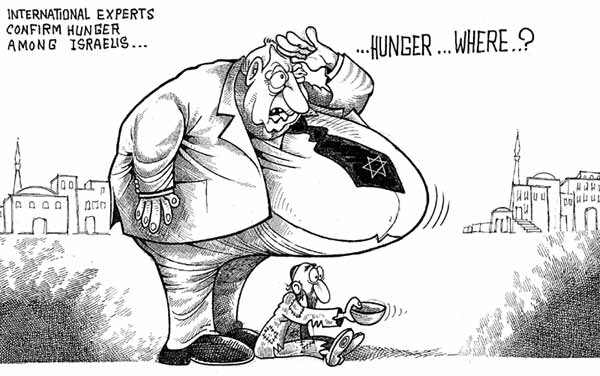
SHARON’S ISRAELI
FINANCE BILL:
Almost
one billion NIS will be cut from children's
allowances. The allowance will be even lower for
Arab children and will be reduced for each
additional child. Sharon's plan to deal with the
mass unemployment is based upon the Wisconsin
Plan: a system of workfare pioneered in the
United States which will "encourage people
to work and not to get money from the
state", as senior government's officials
said. More than 200,000 people in Israel have no
job, and only some of them can get a monthly
income from the state, which is less than the
minimum salary.
Sharon's plan will make the conditions for
receiving unemployment benefits more restrictive.
Today, one must have worked six months in order
to get six months of benefits from the state
after having been fired. The new plan wants to
increase the number of months that a worker needs
to have been in permanent employment from six to
12.
In addition, many benefits granted to the most
deprived layers will be reduced. For example,
single-parent families will receive a maximum of
$US127 housing benefit, instead of the present
$US248 per month.
Only Israeli citizens who serve in the Israeli
Defence Forces (IDF) will get full state
benefits, a proviso that will hit Arab families
(Israel doesn't allow Palestinian Arabs to serve
as IDF soldiers) and the Jewish Orthodox
community, which is exempt from military service.
Both these groups are amongst the poorest in
Israel, and Shas and United Torah Judaism have
both posed as defenders of the poor in order to
safeguard their religious-based constituency.
|
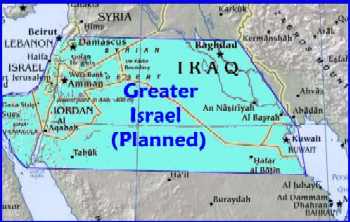 IS THIS A MAP THAT SHARON LOOKS AT EVERY
DAY WITH GREEDY EYES ?? IS THIS A MAP THAT SHARON LOOKS AT EVERY
DAY WITH GREEDY EYES ??
WATER: Continuous
seizure or destruction of Wells or Water-pipes...WestBank
and Gaza:..
Sharon’s government will take
30 wells in the Qalqilia district, seizing water
resources already unequally allocated by the Israeli
government at the 1967 level. A huge aquafer, the Western
Groundwater Basin, lies under Palestine, yet Palestine
remains water poor due to Israeli restrictions, a seldom
mentioned but primary reason for Israel’s keen
interest in the West Bank
Water
Wars: ISM Activists in Gaza Strip Gather To Protect
Water Wells and Supply in Rafah......31. january.2003
Last night Israeli forces attacked
Rafah's water supply at Tel el-Sultan destroying with
bulldozers the 2 largest of six wells that supply the
town's water. This has resulted in a reduction of
50% in the town's water supply.
Tonight 4 ISM activists (2 Americans,, 1 Briton and 1
Swede) will stand guard around the 4 remaining wells
protecting them with their bodies at the request of the
Rafah's Water Municipality Director. The well's are
in a very exposed position - less than a kilometre from
the Gush Katif Settlement, where the occupying army bases
a large portion of its armoured and demolition vehicles.
This action follows a successful action undertaken
yesterday when ISM intervention made possible the repair
of a burst water main in Rafah which had been damaged by
Israeli military activity and had been flooding a street
of Rafah's Brazil area on the Egyptian border for more
than six weeks. On previous occasions municipal
workers had come under machine-gun fire from a nearby
Israeli tank whenever they tried to repair the damaged
pipes.
Yesterday the workers were able to complete the
repairs on the pipes without interference while ISM
activists stood among them and between them and the tank.
Should tonight's action be successful the activists
intend to guard municipal workers installing a pump in a
waterworks building, which they have been prevented from
doing due to machine-gun fire from a nearby tank at Gush
Katif Settlement which overlooks the building
UPDATE:
5th Feb.2003
Water Wars Today six ISM activists based in Rafah (3
American, 2 British, 1 Swedish) are accompanying
municipal workers who are rebuilding a road to Rafah's
main water pumping station northwest of Tel
el-Sultan. The road has been destroyed by the
Israeli Army and both the road and the pumping station
are overlooked by the Rafih Yem Settlement. Repairs
on the road have been prevented from machine-gun fire
from an Israeli tank situated within the
settlement. (Last night a 12 year old boy was shot
in the leg by machine-gun fire from the same tank.)
The activists have used a
megaphone to inform the tank crew that they are
international volunteers and are riding with the
bulldozer crews of the municipal council who are
repairing the road. Tonight they intend to sleep at
the water pumping station and tomorrow they intend to
accompany municipal workers responsible for installing
the new equipment in the station. This action follows on two other successful
actions carried out last week when the Rafah ISM
activists acted as human shields by standing in between
an Israeli tank and municipal workers fixing a ruptured
water main that had been flooding a street in Rafah's
Brazil area (the municipal workers had not been able to
repair the pipe due to machine-gun fire from the tank)
and when they slept at the Tel el-Sultan wells preventing
their demolition (two of the wells had been destroyed by
Israeli Army bulldozers on the previous night cutting
Rafah's supply water by half).
LEBANON: A delegation of American water experts
yesterday toured the Wazzani River in Southern Lebanon to
review projects initiated by the Lebanese government to
direct some of its water to nearby villages. January 2003
The U.S. embassy in Beirut released a statement saying
Israel and Lebanon had agreed to the experts' visit and
the U.S. attempt to resolve differences in the water
dispute. Lebanese officials, however, insisted that the
U.S. delegation is not mediating between their country
and Israel.
Lebanon characterized the American activity as being
"technical," and "unofficial." An
official Lebanese source said "if there is conflict,
it must be resolved in the United Nations framework in
accord with international agreements." Lebanon
President Emile Lahoud released a statement yesterday
saying that ""Lebanon has been deprived of
profiting from its share of the Wazzani spring for many
years because of the Israeli occupation."
Lahoud told a French Senate delegation yesterday that
"Lebanon's decision to benefit from the Wazzani
River's waters to irrigate its parched land and villages
in the south is final and irreversible ... The Israeli
threats will not keep international agreements and
documents from being implemented."
Hashem Haidar, a senior official from the Council of the
South, which is responsible for the water project at the
Wazzani, said yesterday: "We are not changing the
water bed of the river as Israel is saying, and ... we
are taking less than our share of the water to the
villages." "This is Lebanese water and
Lebanese land. Lebanon has the right to give this water
to those citizens who need water to drink," added
Hussein Ahmad, head of the Wazzani municipality.
Lebanese newspapers reported yesterday that the Council
of the South intends to finish the water project at the
Wazzanni within three weeks.
The U.S. delegation featured an official from the United
States Agency for International Development (USAID), and
a State Department official who specializes in water
issues in the Middle East. The American officials
photographed the project at the Wazzani, and also an
Israeli pump near the divided town of Ghajar.
An official at the U.S. embassy in Beirut told Reuters:
"American technical experts will be arriving over
the coming weeks to take a look at water issues and to
work with the Lebanese government to increase
understanding about the nature of the project."
At this point, the Bush administration intends to let
technical experts from the State Department address the
water situation in Lebanon, U.S. officials said in
Washington. The sources said yesterday that high level
officials in the U.S. capital are monitoring the
situation. U.S. representatives at the Wazzani are not
there to judge the legitimacy of conflicting Israeli and
Lebanese claims, the sources in Washington explained.
Instead, the officials are there to listen to both
governments present facts and claims, and to relay a
message designed to allay tensions - the U.S. officials
will urge both sides to resolve the issue via discussion
and negotiation.
According to an Israel Defense Ministry spokesperson, the
ministry's water adviser Noah Kinarti had joined Foreign
Minister Shimon Peres in Washington "in order to
make clear [to the United States] that Israel will not
agree to the water being diverted."
Last week, the Bush administration asked Israel to
moderate its tone on the water crisis after Prime
Minister Ariel Sharon warned Lebanon not to divert water
from the springs, saying any attempt to do so could
provoke a military response.
The water issue was raised by Foreign Minister Shimon
Peres in meetings Friday in Washington with
Vice-President Richard Cheney and National Security
Advisor Condoleezza Rice. Peres called the plan to divert
water a "provocation that [is] in violation of
agreements and international law."
Jan.20.2003 Ha'aretz
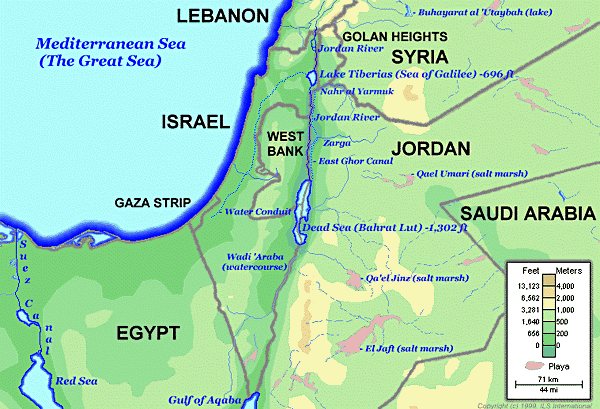
Spate of studies on water projects reflects Israel's
appetite for every drop
WATER AND PEACE: WATER RESOURCES
AND THE ARAB-ISRAELI PEACE PROCESS by Elisha Kally
with Gideon Fishelson, Praeger Publishers, Westport,
CT 06881, US. 1993, pp.127. Hbk: US$47.95.
By Khalil Osman
The quest for water to satisfy the burgeoning needs of
an ever-increasing number of Jewish settlers in arid
Palestine is as old as zionism itself. Theodore Herzl,
the founding father of political zionism, recognized the
vital importance of water for the success of his
colonialist project. As far back as 1902. he published a
novel entitled Altneuland (Old-New Land) in which
he proposed a number 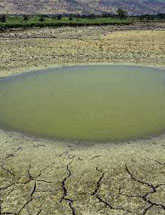 of
ideas, some of which envisaged inter-basin transfers.
mainly from Lebanon's rivers and the headwaters of the
Jordan River, to augment the water resources of and to
generate hydroelectric power for the future 'national
Jewish homeland' in Palestine. of
ideas, some of which envisaged inter-basin transfers.
mainly from Lebanon's rivers and the headwaters of the
Jordan River, to augment the water resources of and to
generate hydroelectric power for the future 'national
Jewish homeland' in Palestine.
The acute awareness of the importance of water for the
success of their colonialist project fostered a
water-mania among the zionists which manifested itself in
a spate of studies and master plans that aim at
controlling almost every drop of water that flows in
Palestine and some of its neighbouring countries. Schemes
to establish a region-wide water management regime that
predominantly reflects Israel's hegemonic concerns have
continued to proliferate to the present day. Nestled in
this tradition, the book under review proposes a master
plan for solving the water shortage problem in the
southern Levant region within the framework of a regional
peace agreement.
The book is divided into three parts. Part 1, written
by Gideon Fishelson, an Economics professor at Tel Aviv
University, provides a brief historical overview 'of the
development of water resources, particularly west of the
Jordan, and the conflicts between Israel and its
neighbouring countries as they relate to the issue of
water' (p.3). This survey, which covers the period from
the beginning of the British Mandate on Palestine to the
present, suffers from excessive compression and lacks
clarity of exposition.
Objectivity in presenting historical facts does not
appear to be a major concern of the author. Rather, his doctrinaire bias
clouds much of the historical account. For example, he is
at pains to exonerate Israel of responsibility for
foiling past water development projects in neighbouring
Arab countries and pinning blame squarely on the Arabs
themselves. This is evident in his sketchy account of the
failure of the Syrian and Jordanian governments to carry
out the building of the joint Maqarin Dam on the Yarmuk.
Fishelson argues that the project has been blocked by the
inability of both governments to arrive at a
water-sharing agreement. It is true that disagreement
over water sharing has marred relations between Syria and
Jordan from time to time: however, the author's account
glosses over the fact that it was Israeli veto that has
frustrated these countries' efforts to secure the needed
international funding for the project. Rather, his doctrinaire bias
clouds much of the historical account. For example, he is
at pains to exonerate Israel of responsibility for
foiling past water development projects in neighbouring
Arab countries and pinning blame squarely on the Arabs
themselves. This is evident in his sketchy account of the
failure of the Syrian and Jordanian governments to carry
out the building of the joint Maqarin Dam on the Yarmuk.
Fishelson argues that the project has been blocked by the
inability of both governments to arrive at a
water-sharing agreement. It is true that disagreement
over water sharing has marred relations between Syria and
Jordan from time to time: however, the author's account
glosses over the fact that it was Israeli veto that has
frustrated these countries' efforts to secure the needed
international funding for the project.
Parts II and III, written by Elisha Kally, former head
of the long-range planning group of TAHAL, Israel's water
planning agency, constitute the major and noteworthy
segment of the book. Part II consists in a regional
hydrological investigation. It surveys the region's
available surface and subterranean water resources,
examines national water development policies in the
respective countries. explores their major water
problems. and provides some projections of their future
water demand. The author alludes to a host of factors
that contribute to the emergence of a water crisis in the
region. These include population growth, expansion of
industry and agriculture, increased urbanization and
inefficient maintenance of water facilities as well as
wasterful irrigation techniques.
Part III, which is the more interesting part of the
book, is devoted to presenting Kally's manifold.master
plan that envisions the importation of substantial
amounts of water to supplement the declining regional
resources - primarily those of Israel, and secondarily
those of Jordan as well as the West Bank and Ghazzah
Strip.
The major component project of the plan comprises the
diversion of one percent of the Nile water 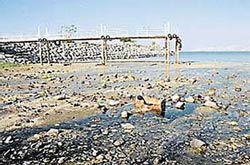 eastward 'to the Gaza Strip, to
Israel's Negev and, under certain conditions, to the West
Bank and Jordan as well' (p.66). Kally argues that the
project would also be facilitated by current 'Egyptian
plans to transport water to the Sinai Desert and to
construct irrigation projects there ... The joint
Israel-Egyptian project under discussion could thus
comprise an expansion and extension of the Egyptian
enterprise' (p.67). eastward 'to the Gaza Strip, to
Israel's Negev and, under certain conditions, to the West
Bank and Jordan as well' (p.66). Kally argues that the
project would also be facilitated by current 'Egyptian
plans to transport water to the Sinai Desert and to
construct irrigation projects there ... The joint
Israel-Egyptian project under discussion could thus
comprise an expansion and extension of the Egyptian
enterprise' (p.67).
Supplying Nile water to the Negev desert would relieve
Israel of the exorbitant costs incurred by the present
system of supply from the Sea of Galilee (Lake Tiberias
or Kinneret). In exchange, water that used to be pumped
to the Negev from the Sea of Galilee could be conveyed to
the West Bank, and possibly to Jordan.
Another component project of Kally's master plan is
based on storing the winter floods of the Yarmuk River in
the Sea of Galilee. Kally maintains that this project
'will make from 100 to 240 million cubic meters of water
that is currently running to waste available for use to
Jordan and Israel' (p.83). Since the salinity of the Sea
of Galilee, which is fed by a number of saline springs,
is high, the conveyance of the Yarmuk water could reduce
its salinity by 20 percent. That will make Israel the
main beneficiary of the project as the Sea of Galilee
serves as its main aboveground water reservoir.
Kally's master plan also envisages conveying water
from the Red Sea to offset the progressive diminution of
the water level in the Dead See which results from the
utilization of substanital amounts of water from the
Jordan River and its tributaries. The Red Sea-Dead Sea
canal project would include an intake installation and a
reservoir on the Red Sea, an open canal, and 'two power
stations, one in Jordanian territory east of Beer Ora and
one in Israeli territory north of Neot Hakikar' (p.93)
which uses differences in elevation to generate
hydroelectric power.
The last major component project is that of conveying
Lebanese water to Israel. In this context, water from the
Litani River would be diverted via a tunnel to either one
of two Jordan River tributaries which rise in Lebanon,
the Hasbani or the Ayoun. The diverted Litani water,
which is characterized by an exceptionally low salinity
level (less than 20 mg/l), would then be stored in the
Sea of Galilee thus contributing to reducing its
salinity. Moreover. Kally estimates that his proposed
diversion of Litani water would make possible the
production of a total about 70 million kilowatt-hour of
electricity.
Overall, none of the projects proposed or discussed by
Kally is new or original . Many variations of these
projects have been proposed by others in the past. For
instance. the idea of diverting Nile water to facilitate
the settlement of Jews in the area was first considered
by Herzl at the turn of the century. In the mid-1940s,
the World Zionist Organization assembled a team of
researchers and experts to prepare a comprehensive study
that would serve as the basis of a water network in the
future Jewish state. J B Hayes, an American engineerwho
headed the team, published an all-inclusive plan that
envisioned major transfers from the Yarmuk, the principal
tributary to the Jordan River, and the Litani, the
largest Lebanese river, to maximize the area of culivated
land in Palestine.
The significance of Kally's plan, however, lies in his
ability to synthesize these divergent schemes into an
integral whole. Nevertheless, the welter of projects,
alternative projects, technical details and future
projections advanced by Kally fly in the face of
fundamental international legal principles regulating the
utilization of transboundary and international water
resources. In addition, it is premised on a plethora of
flawed estimates of the available resources and future
needs of regional countries that would render his master
plan an exercise in futulity.
For instance, Kally's total exclusion of Syria from
his plan is rather perplexing, especially in light of the
claptrap about 'peace' in the region that peppers the
pages of the book. Since some of Jordan River's
tributaries rise and flow in Syrian territories, Syria
enjoys all riparian rights in line with such provisions
of international law as those included in the Helsinki
Rules for the Use of International Rivers.
Kally's plan, moreover, is based on erroneous
assumptions regarding the availability of water surpluses
in Egypt and Lebanon. The fact that water resources in
Lebanon have not yet been fully or efficiently utilized
is a consequence of the negligence and dereliction of
duty on the part of consecutive Lebanese governments
rather than being an indicator of a real low water demand
in the country. Estimates by Lebanese hydrologists and
the country's Ministry of Water and Hydroelectric
Resources indicate that by the year 20l5 the country's
water demand will approach its total available resources.
Likewise, contrary to Kally's claims, Egypt is not a
water-rich country. It is estimated that Egyptian
utilization of the Nile water will reach capacity use by
the year 2,000. By the year 2025, water deficit in Egypt
is expected to reach about 29 billion cubic metres per
year. The realization of the impending water crisis in
the countly has led the Egyptian government to embark on
a number of projects that utilize non-conventional water
techniques, such as desalination or sewage treatment, to
enhance the country's water balance.
Moreover, the Nile River is shared by nine African
States some of which have so far achieved abysmal levels
of economic development. These countries will inevitably
increase pressure on the Nile waters as they begin to
undergo economic rejuvenation and to carry out
agricultural expansion plans. In addition to infringing
on the rights of the river's ripal-ians, the diversion of
Nile water to a non-riparian could establish the latter'
s de facto right to to the river's water under
international law. Kally himself is fully aware of such
an eventuality when he scoffs at demands placed on Israel
to cease its ongoing theft of the water resources of
Syria, Jordan, the West Bank and Ghazzah Strip as being
'at odds with international law, which recognizes
existing rights as holding precedence over future claimed
rights' (p.58).
Khalil OsmanŠ 1997
|


 IS THIS A MAP THAT SHARON LOOKS AT EVERY
DAY WITH GREEDY EYES ??
IS THIS A MAP THAT SHARON LOOKS AT EVERY
DAY WITH GREEDY EYES ??
 of
ideas, some of which envisaged inter-basin transfers.
mainly from Lebanon's rivers and the headwaters of the
Jordan River, to augment the water resources of and to
generate hydroelectric power for the future 'national
Jewish homeland' in Palestine.
of
ideas, some of which envisaged inter-basin transfers.
mainly from Lebanon's rivers and the headwaters of the
Jordan River, to augment the water resources of and to
generate hydroelectric power for the future 'national
Jewish homeland' in Palestine.  Rather, his doctrinaire bias
clouds much of the historical account. For example, he is
at pains to exonerate Israel of responsibility for
foiling past water development projects in neighbouring
Arab countries and pinning blame squarely on the Arabs
themselves. This is evident in his sketchy account of the
failure of the Syrian and Jordanian governments to carry
out the building of the joint Maqarin Dam on the Yarmuk.
Fishelson argues that the project has been blocked by the
inability of both governments to arrive at a
water-sharing agreement. It is true that disagreement
over water sharing has marred relations between Syria and
Jordan from time to time: however, the author's account
glosses over the fact that it was Israeli veto that has
frustrated these countries' efforts to secure the needed
international funding for the project.
Rather, his doctrinaire bias
clouds much of the historical account. For example, he is
at pains to exonerate Israel of responsibility for
foiling past water development projects in neighbouring
Arab countries and pinning blame squarely on the Arabs
themselves. This is evident in his sketchy account of the
failure of the Syrian and Jordanian governments to carry
out the building of the joint Maqarin Dam on the Yarmuk.
Fishelson argues that the project has been blocked by the
inability of both governments to arrive at a
water-sharing agreement. It is true that disagreement
over water sharing has marred relations between Syria and
Jordan from time to time: however, the author's account
glosses over the fact that it was Israeli veto that has
frustrated these countries' efforts to secure the needed
international funding for the project.  eastward 'to the Gaza Strip, to
Israel's Negev and, under certain conditions, to the West
Bank and Jordan as well' (p.66). Kally argues that the
project would also be facilitated by current 'Egyptian
plans to transport water to the Sinai Desert and to
construct irrigation projects there ... The joint
Israel-Egyptian project under discussion could thus
comprise an expansion and extension of the Egyptian
enterprise' (p.67).
eastward 'to the Gaza Strip, to
Israel's Negev and, under certain conditions, to the West
Bank and Jordan as well' (p.66). Kally argues that the
project would also be facilitated by current 'Egyptian
plans to transport water to the Sinai Desert and to
construct irrigation projects there ... The joint
Israel-Egyptian project under discussion could thus
comprise an expansion and extension of the Egyptian
enterprise' (p.67).